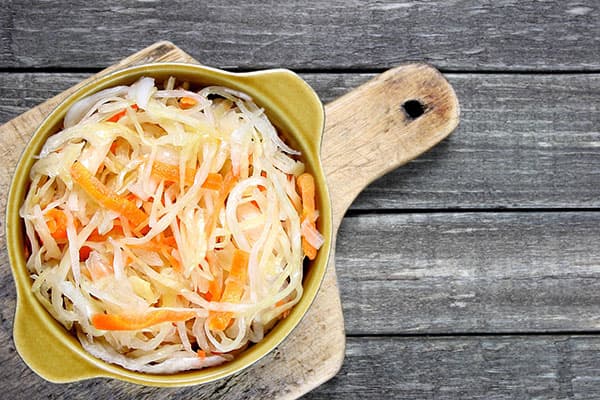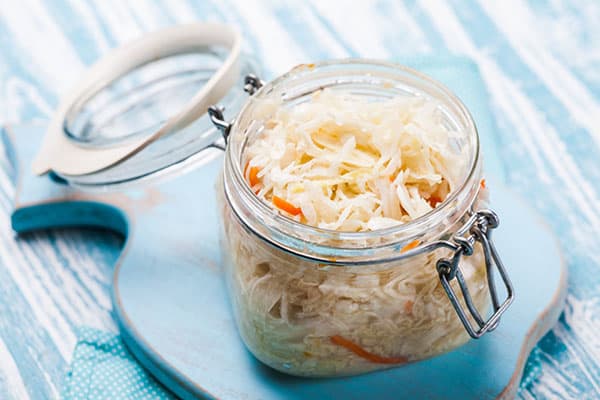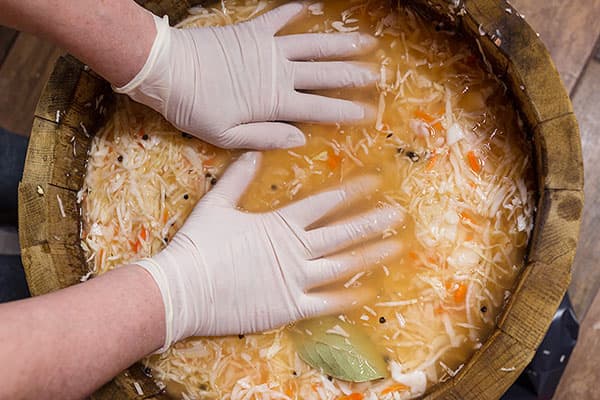Fermented cabbage recipes: classic and without salt
There is an opinion that fermented food is something like a cure for all diseases. In Russian cuisine, the most popular is sauerkraut (fermented) cabbage, the recipe for which you will find below. Increasingly, it is prepared without salt to obtain maximum health benefits. This cabbage is rich in probiotics, vitamins B, C, K, potassium, and calcium. Fermentation allows you to enhance the beneficial properties of the product, improve the taste and extend the shelf life up to 8 months.

How to ferment cabbage?
Fermentation is a fairly simple chemical process involving protein catalysts - enzymes. With its help, not only sauerkraut is produced, but also many other products and dishes: beer, wine, cheese, vinegar, tea, kefir, yogurt, kimchi, miso. Enzymes break down organic substances into simpler forms, after which they are better absorbed and have a beneficial effect on digestion. Fermented foods are also valued for their flavor, which becomes brighter and more pronounced.
Fermented cabbage is a product of lactic acid fermentation. Lactobacilli living on its surface, under certain conditions, begin to multiply and contribute to the fermentation of the product. To start the process, you need heat, a lack of oxygen and food for bacteria (for example, plant sap). The head of cabbage is cut, crushed and left under pressure for several days at room temperature.
You can ferment cabbage in different ways:
- With salt. It makes the taste of the dish pleasant and balanced, suppresses the development of pathogenic microorganisms. Sauerkraut with salt turns out crispy, so it is recommended to add at least a little of it during fermentation.
- Without salt. You can ferment vegetables without adding salt. Contrary to popular belief, it is not salt that gives fermented foods their taste, but lactic acid. Moreover, if salt is not used, fermentation accelerates significantly.
The term “fermentation” was first used in 1901 to describe the method of preparing tea. As a result of enzymatic oxidation, the leaves darken and acquire the characteristic aroma of black tea. Green, white, yellow, black, oolong, and pu-erh tea can be prepared from tea leaves of the same type by stopping the fermentation process at different stages.
7 rules of fermentation
To prepare tasty and healthy cabbage, you need to know the basic rules for its preparation:
- Choose the freshest possible vegetables for fermentation, if possible, home-grown vegetables free of chemical additives. The head of cabbage should be clean of stains, uniform in color, crunchy and smell good.
- Wash vegetables thoroughly before fermenting. There should be no soil left on them, otherwise they may begin to rot. The soil may also be contaminated with botulinum toxin. In the absence of oxygen, the rod actively multiplies and causes the disease botulism.
- Choose the right container - glass or ceramic. Cabbage will be stored in it for weeks, or even months, and it is important that it does not absorb harmful substances. It is not advisable to use metal and plastic utensils for fermentation.
- Prepare a weight - a heavy object that will press the vegetables, preventing them from floating.They must be immersed in brine at all times, otherwise mold will begin to form on top.
- Consider insect repellent. Usually the vessel is covered with a lid or gauze.
- Squeeze out the juice. For fermentation to occur, the cellular structure of vegetables must be destroyed. To do this, they are beaten with a meat mallet, a wooden masher, or simply crushed by hand.
- When the cabbage reaches the desired taste, move it to a cool place to slow down the fermentation process and preserve it for a long time. As it ferments, the flavor will become stronger.
Classic recipe
To prepare classic sauerkraut you will need the following ingredients:
- 3 kg of white cabbage;
- 75 g table salt;
- 300 g carrots.
The cabbage must be finely chopped and the carrots grated on a coarse grater. Next, the mass is sprinkled with salt, kneaded and packed tightly into jars. You need to put pressure on top so that the vegetables are completely immersed in the released juice. If after 8–12 hours it is still not enough, you can add boiled water. Ready!
Then the cabbage will ferment on its own. It is enough to leave it warm (20–22 degrees). To avoid bitterness, it is recommended to pierce it with a wooden stick from time to time, releasing carbon dioxide. Usually it reaches readiness on the 3-5th day.
You can ferment cabbage in large pieces or shredded. The smaller it is, the sooner the process will be completed.
Recipe without salt
As mentioned earlier, no salt is needed for fermentation. It acts as a preservative and flavoring agent in the recipe.
Ingredients for making salt-free fermented cabbage:
- 3 kg of white cabbage;
- 300 g carrots;
- 200 ml of brine from previously fermented cabbage (if available);
- 300 g Antonov apples (optional);
- 100 g cranberries or lingonberries (optional);
- dill seeds, bay leaf, peppercorns or other spices (optional).
The preparation is identical: the cabbage is chopped, the carrots are grated on a coarse grater, and then the mass is kneaded with your hands and compacted into a jar. The problem with this recipe is getting the juices out. In the absence of salt, it is excreted poorly. To get it, you need to prepare heavy oppression. If after 8-12 hours the liquid still does not cover the vegetables, you need to pour boiled water.
Some people prefer to use brine. It is best to take it from previously fermented cabbage. But you can also cook it separately. To do this, you should finely chop 200 g of cabbage leaves, mash, pour cold boiled water and leave to ferment for 2-3 days in a warm place. After the specified time, the brine is filtered and used in the recipe for fermented cabbage without salt.
Fermented cabbage is served with fatty and smoked meat, sausages, and frankfurters. It is also used for preparing various dishes: Russian cabbage soup, German kabbes, Polish bigos and others.
Product benefits
Fermentation allows you to enrich the product with vitamins B, K, C, probiotics, and omega-3 fatty acids. Fermented cabbage does not spoil for a long time and can be stored for months. It preserves nutrients better than freezing.
What are the health benefits?
- Cabbage leaves contain a lot of ascorbic acid, which improves immunity and protects against colds.
- During the process of lactic acid fermentation, the contents of the jar are saturated with probiotics, which improve digestion and restore the microflora in the intestines after treatment with antibiotics.
- Fermented cabbage is rich in dietary fiber and is easily digestible. It helps cleanse the intestines, helps in the fight against chronic constipation, excess weight and fluid retention in the body.
- Thanks to antioxidants, regular use of the product cleanses the skin. It is believed that sauerkraut prolongs youth.
- It helps suppress the activity of Helicobacter pylori, a bacterium believed to cause peptic ulcers.
- When consuming fermented cabbage, the body produces better blood cells, removes harmful cholesterol, and strengthens the heart muscle and blood vessels.
According to legend, cabbage should not be fermented during the full moon.
Harm of fermented cabbage
Many people are wary of eating sauerkraut, calling it rotten. In the case of fermentation, the line between a delicacy and a spoiled product is very thin indeed. It is important to prevent harmful microorganisms from entering the jar. But if everything is done correctly, lactic acid will soon begin to form, which suppresses pathogenic flora and is a kind of preservative.
Otherwise, the harm of fermented cabbage concerns health contraindications. It is not recommended to eat too much of it, or on an empty stomach, to avoid increasing the acidity of gastric juice. Otherwise, unpleasant consequences are possible:
- heartburn;
- flatulence;
- diarrhea.
People with the following diseases should also avoid the product or limit its consumption to a minimum:
- gastritis;
- peptic ulcer;
- pancreatitis;
- renal failure;
- urolithiasis disease.
Almost any vegetables can be fermented. Try experimenting with different types of cabbage - cauliflower, broccoli, Chinese cabbage.
Fermenting vegetables allows you to enjoy summer's bounty all year round. You can prepare cabbage without salt, with salt, with various berries, spices, carrots, apples and other additives. First, try the classic recipe. Having prepared the dish at least once, you will understand the principle itself and will be able to add or remove ingredients to your taste.






“The soil can also be contaminated with botulinum toxin. In the absence of oxygen, the bacillus actively multiplies and causes the disease botulism.”
1. There is NEVER botulinum toxin in the soil!
2. The rod (clostridia) does not cause ANYTHING when it enters the body!
3.Botulism is not a disease, but poisoning. And - acute poisoning!
4. What kind of cabbage fermentation are we even talking about here?! Normal bacterial lactic acid fermentation!
5. The information is clearly from a person who is not very knowledgeable in matters of food technology.
The natural habitat of S.botulinum is the intestine of many predominantly herbivorous animals, as well as fish, crustaceans, and mollusks, in which they reproduce and are excreted in feces into the environment. Clostridium botulism spores are found in significant quantities in soil, water, and sludge. They are resistant to high temperatures and can withstand boiling for 1-5 hours. Infection occurs through nutrition. The cause of poisoning is the consumption of fish, vegetables, canned meat and other food products, in particular those canned at home.
Hm. In everything related to botulism and C. botilinum, the author, of course, does not understand the word at all.
But when it comes to fermentation, she's right. All 3 types of fermentation used in cooking (lactic acid, alcoholic and acetic acid), as well as mixed types, are precisely a special case of fermentation using microorganisms. It’s just that in the Russian tradition they usually don’t use the word “fermentation” for, for example, pickling (aka lactic fermentation). But in English and others they quite use it. Thus, lactic acid fermentation is called “lactofermentation”. Not only in culinary, but also in scientific literature too. ))
Thank you for the story about fermentation WITHOUT salt! I myself always adored sauerkraut, I could literally grind it by the kilogram, with unrefined cabbage, with sunflower, eh?! But for some time now I have stopped actively using it to minimize salt consumption.
Now I'll start again!
I can't eat salt either. I myself thought of doing the same. You can ferment it with a spoon or two of feta brine. There are lactobacilli there too.
Thanks for the article. Everything is clearly written. Just think, they were slightly mistaken about botulism.That’s not the point, it’s important that everything must be washed clean so that particles of earth, which may contain bacteria(?) that cause botulism, do not get into the finished cabbage. It would be possible to write more about lactic acid fermentation. Anyway. But as for crispiness, there’s a little secret: the heavier the load, the crispier the cabbage. And one more thing about juice and water. If you use a masher when placing the cabbage in a container, you will get a lot of juice and won’t have to add any water.
I think that if you ferment cabbage this way without salt, in a week you will get a jar of fragrant crap. First, go to the “Effective Microorganisms” website, read carefully and your philosophy of thinking will change. To ferment cabbage, it is better to use EM Kurungi starter, which is sold in Siberian Health stores. A very wonderful product.
in the villages they did this all their lives, they poured rye flour at the bottom, then lined it with cabbage leaves and horseradish leaves, then they laid shredded cabbage in layers, sprinkled it with salt, filled a barrel, on top of a canvas cloth, put a wooden circle on it and press it down, after a few days foam will appear, remove the foam, When the foaming ends, the cabbage is ready, if mold forms on top, remove the rag and the lid with pressure, rinse everything with boiling water and return it to its place, that’s the whole wisdom of sauerkraut)))
I read that a certain temperature is needed for fermentation and the production of lactic acid bacteria. Here we are talking about 20-32*C. What do you think?
I tried to make cabbage according to the recipe without salt. The result was delicious crispy cabbage. I would never have thought that you could get something like this without salt.